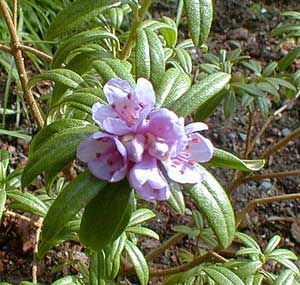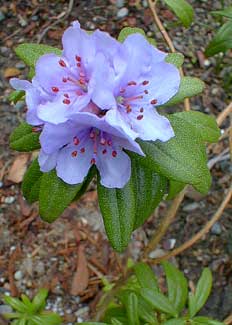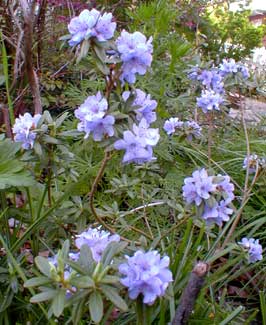
Rhododendron hippophaeoides,
a Yunnan dwarf lepidote
"The temple bell stops
but I still hear the sound
coming out of the flowers."
-Matsuo Basho
(1644-1694)
(1644-1694)
"This is a particularly charming rhododendron," notes David G. Leach in Rhododendrons of the World (1961), "with tiny nosegays of color at the end of almost every twig."
Rhododendron hippophaeoides, which received the Award of Garden Merit in 1925, is a small evergreen shrub we planted at the front of a perennial bed, so that there'd be something evergreen & pleasing in that spot even in winter when the perennials have largely died back.
Ours started out only about 18 inches high when first planted. Within the first year it gained several inches mostly in width & produced several additional limbs, with the tangled reach of an octopus.
 As dwarf rhodies go, it is not destined to be one of the smallest. Its ten-year height is three to four feet, with an open appearance revealing its appealing structure.
As dwarf rhodies go, it is not destined to be one of the smallest. Its ten-year height is three to four feet, with an open appearance revealing its appealing structure.The majority of dwarf lepidotes have lilac or purple flowers, as does R. hippophaeoides, though its flowers are of a more pastel lavender, leans very much toward blue.
Each fat tubular flower is a half-inch wide, in cute miniature trusses of four to eight, as seen in the early April (2003) photo above, with the second photo snapped in the third-week of April. The third photo from mid-April 2004 shows more of the twiggy structure.
A few specimens have been known to have a second bloom in autumn, as early August. In 2004, ours began to rebloom, if a little tepidly, late in September, with some buds opening in early October. Other rebloomers in our gardens are 'PJM Elite' & 'Lee's Best Purple.' Another rhody does not bloom in spring, but flowers so late in summer it is sometimes still in flower for autumn, namely Nakahara's 'Mount Seven Star.'
Most dwarf evergreen lepidotes are darned easy to grow, & this one's one of the easiest of the easy. It does well in sun or partial shade, though it will get lanky if placed in too much shade. It is more tolerant of wet-foot than just about any other rhody, as in the wild it selects locations that are moist to boggy. It stands very upright & bushy at maturity, though judging by ours, it can be slightly floppy or "weeping" when young.
 A native of very high alpine regions of Yunnan & Sichuan, China, it's easily cold-hardy to minus ten, & possibly to minus twenty-five. It is not damaged by a mild frost even when in flower. On the other hand, it is not tolerant of warm climates.
A native of very high alpine regions of Yunnan & Sichuan, China, it's easily cold-hardy to minus ten, & possibly to minus twenty-five. It is not damaged by a mild frost even when in flower. On the other hand, it is not tolerant of warm climates.There are many Chinese dwarf lepidotes, but the majority are not in wide distribution in the garden trade. R. hippophaeoides is a bit more easily obtained than most, as it has been longer in cultivation as a species shrub.
It was introduced to the west by plant explorers George Forrest in 1903, & into cultivation by Frank Kingdon-Ward in 1913. Our specimen came to us through the Rhododendron Species Foundation, which in turn got their stocks started from a strain grown at the Royal Botanical Gardens in England.
Although fully evergreen in Zone 8, its winter behavior is a bit different in much colder regions than ours, where the leaves turn brown & curl in winter, looking as though they are sun- & wind-dessicated. It does not have this behavior in our mild winters on Puget Sound. In such a mild climate as ours, it even takes on some autumn colors of sufficient interest that I have included a R. hippophaeoides Page for the Autumn Azaleas & Rhododendron Walk, which see.
I'm rather glad it doesn't get that brown curled winter look in our zone, but if it did, that wouldn't indicate the shrub was unhealthy, for come spring the leaves return to their shiny green uncurled appearance. I suppose it is possible that this trait is easily passed on in hybrids, & that would be why there don't seem to be many dwarf hybrids developed for the nursery trade using R. hippophaeoides in breeding programs.